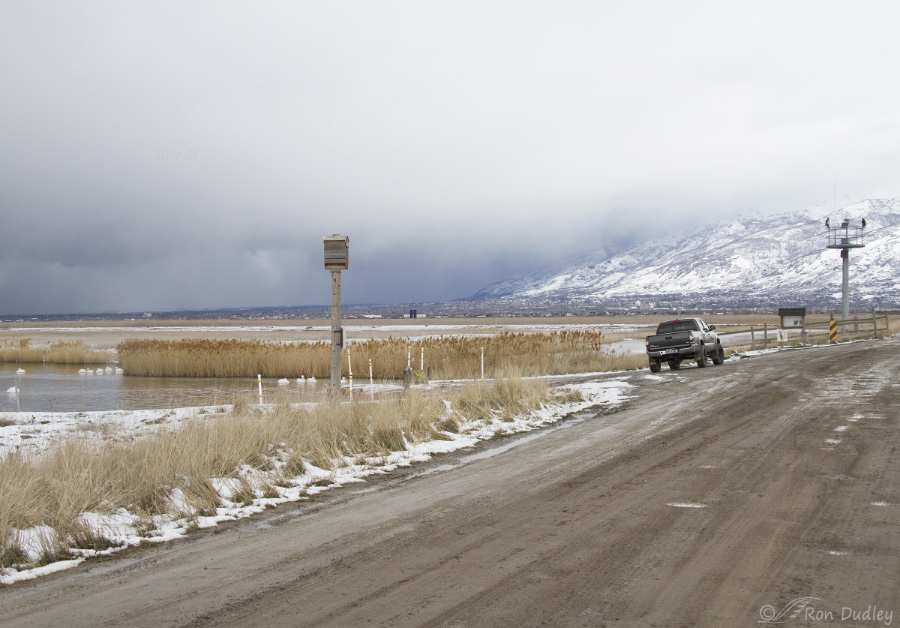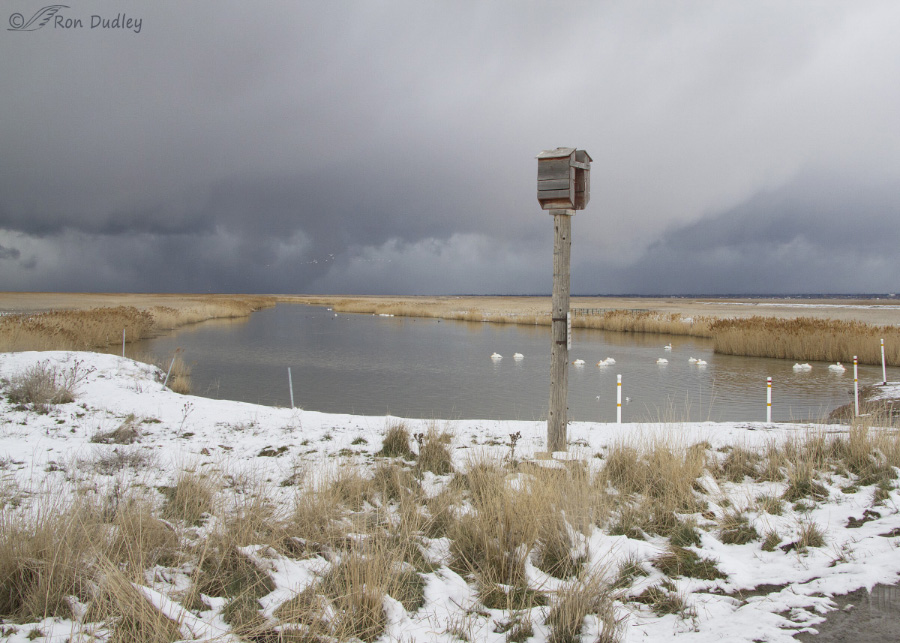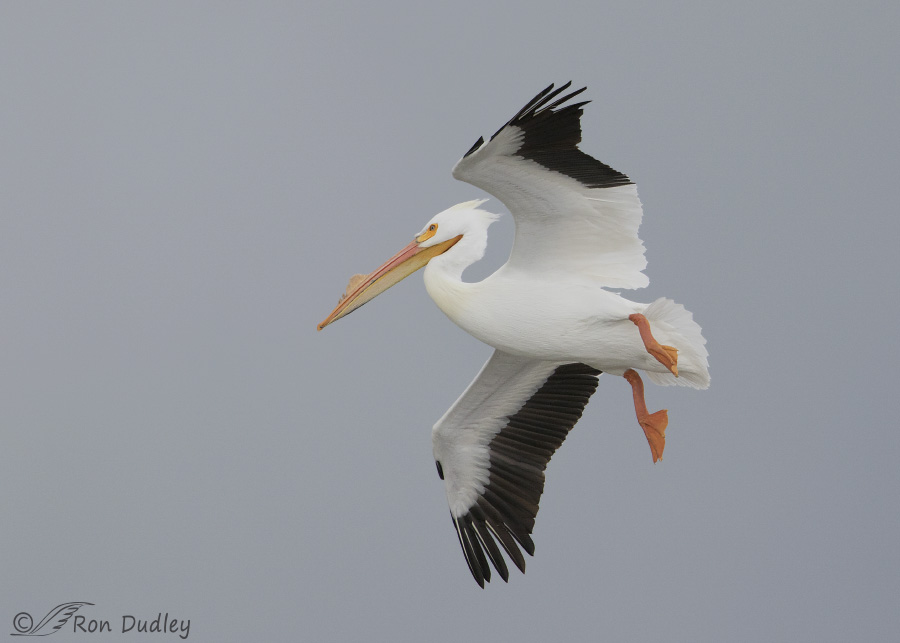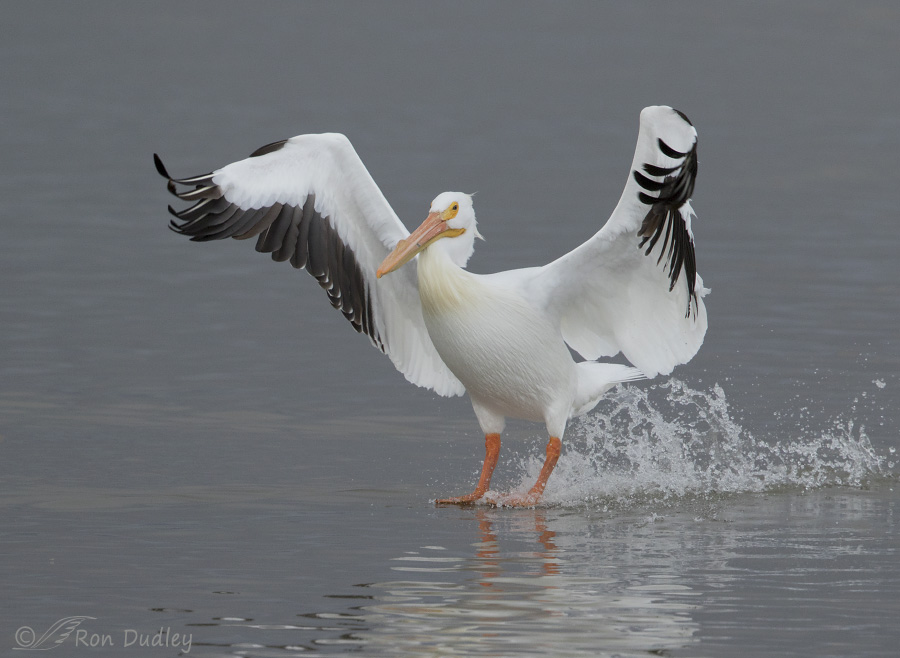Every year I have ambivalent feelings about the arrival of March 1. It signifies another step toward the return of spring birds and the color green but it also means that I’ll be unable to access Farmington Bay WMA for many months. Almost the entirety of the refuge closes to visitors on March I for the breeding season and it won’t reopen again until late fall, several weeks before the beginning of duck hunting season.
So late yesterday afternoon when a brief opening in the clouds appeared I headed to Farmington to say goodbye. By the time I got there (it’s a 35+ minute drive for me) that blue “sucker hole” in the clouds had pretty much disappeared but I made the tour anyway. And I’m glad I did because despite the dismal light American White Pelicans saved the day.
I thought regular readers might enjoy seeing this photo because it shows several “landmarks” that should be familiar to them. I often refer to the “owl bridge” and part of that bridge can barely be seen just to the right of the yellow and black sign at the right of the frame. Most of us call it the owl bridge because of the two plastic Great Horned Owls we can see at the top weather station next to the bridge. Not long ago I posted a photo of a kestrel perched on the head of one of those owls. And just recently I posted several photos of a subadult Bald Eagle perched on top of the bat box we see on top of the pole near the center of the frame.
When I took this shot I was on my way home after being mostly skunked, largely because of poor light. On impulse I stopped my truck just to watch the pelicans we see on the canal. I wasn’t tempted to photograph them because they weren’t doing much of anything interesting and besides there was already another photographer (in the dark pickup) parked in the best spot. I’d only seen a single pelican in flight during the entire 70 minutes I’d been at the refuge and flight shots of pelicans would be my greatest interest.
But suddenly things began to morph into a very interesting situation.
A dark and menacing storm front was moving in very quickly from the northwest and I suddenly began to see groups of pelicans in flight. Lots of them! If you squint you can see one of the first of those groups just above the horizon at left-center of the frame. I knew what was happening – hundreds of pelicans that had been feeding far out in the large, unprotected impoundments were aware of the approaching storm and were coming in to land on the narrow canals where they’d be more protected from the storm when it hit.
So I pulled over to the side of the road and waited for some of them to land here because I was after flight shots, especially with those dark storm clouds in the background.
When a bird lands on water why don’t we call it “watering” instead of “landing”? Sorry about that – rhetorical question… 🙂
1/1250, f/6.3, ISO 640, Canon 7D Mark II, Canon EF 500mm f/4L IS II USM + EF 1.4 III Extender, not baited, set up or called in
When a large, lumbering pelican comes in to land it’s usually a slow, gliding process without much wing-flapping so most photos of it are similar but I caught this one in a banking posture I like. That heavy body (16+ pounds – think of your Thanksgiving turkey) has a lot of inertia so they lower their legs and spread their webbed toes to help slow them down.
1/2000, f/6.3, ISO 640, Canon 7D Mark II, Canon EF 500mm f/4L IS II USM + EF 1.4 III Extender, not baited, set up or called in
I caught this one practicing its surfing skills.
I got quite a few shots that I think I’m going to like but so far I’ve only had time to glance at them (I didn’t get home until very late in the day and reviewing, culling and processing images takes time – lots of it). I’ll likely post more of them in the future.
I’m gonna miss Farmington. I always do…
Ron






Ron,
Nice shots of the Pelicans. I always wonder how they even get airborne! I too will miss Farmington. I forgot until I went out there Thursday at 4:30 in preparation to enjoy the setting sun… not. Until fall, I guess.
Stephen
As a fan of pelicans (I’m a Louisiana girl by the raisin’) I adore these pelican shots! 😀
These are beautiful shots. I did not know this place is closed during breeding season but that is good for the birds.We have a boardwalk out of town that shuts down for part of the season to prevent harassment of the black terns….or it might be to prevent their harassment of people because they will attack.Regardless they need the peace to bring up their young.Where to next?
Your shots sure beat mine I took 2 weeks ago. I think this is the best shots I have ever seen of a Pelican. Good for you Ron!
I have some beautiful shots of pelicans at Farmington bay on Sunday morning. It was an incredible feeding frenzy of pelicans and cormorants. I will miss going out in my moving blind car but I ride my bike out while parts of the dikes are still open. I get my bird fix for a few hours and exercise at the same time. I am depressed Bear River is still closed, I hope it opens soon. I usually spend part of my spring break at BRMBR. Maybe I will have to plan a trip to Nebraska this year to see the Sandhill Cranes if our local refuges are still closed.
April, I rode my bike out to the 4-way after the road was closed to vehicles… ONCE! It won’t happen again. You can imagine what it was like with my huge 500mm lens and other gear. But that was the only time I’ve ever seen and photographed Black Terns. Crappy photos but it was fun to see them .
Please excuse the silly comment…as if it matters if I comment or not! I just wanted to say how interesting it was to see more of your shooting grounds, including the “owl bridge”…and to say how muchI like the white pelican images, especially the second with its curled primaries and the colors…that snowy white with sooty black wing tips and those bright orange legs and feet. I found the comments interesting, too…didn’t realize that they weighed so much…16 lbs.!!!! Like an airborn Thanksgiving turkey…
Of course it matters if you comment. We’d miss you if you didn’t!
They’re huge, Patty – they weigh twice as much as a Brown Pelican – 16 lbs vs. 8 lbs.
I think the one I carried for about 2 miles at the Spiral Jetty weight around 25 pounds. It was very salt encrusted. They can weigh up to 30 pounds. Their wing span is 9 feet and they stand 3 to 4 feet tall. They are a big bird. About the only bird larger I have had to wrestle was a Tundra Swan.
April, I just went with the weight listed in Sibley – 16.4 lbs.
However, Birds of North America Online lists one report (by my old Ornithology professor at the U of U Dr. William H. Behle) of an American White Pelican that weighted a whoppinhg 29.92 lbs!
Oooh. And Ahh.
I feel your pain but love that the centre closes over breeding season.
Thank you, EC.
Beautiful Shots! It’s nice to get a glimpse of those wide open spaces where you capture all those great images.(I’m from New England)Thanks for sharing your little piece of paradise with us.
Joanne, Farmington is a wonderful and beautiful place, especially when it greens up a little!
Ah yes, white pelicans. They hold a special place in my heart. When they do the flock thing, that magical formation flying that I’ll bet humans couldn’t perform for more than a short bit, it’s simply profoundly beautiful. White pelicans wintered at White Rock Lake in Dallas and I lived a block away from the park…oh just splendid! And yes, I’m easily amused 🙂
Like you, I always mourned when the white pelicans moved on to wherever they moved on to at the end of winter, but I also knew they’d be back and the magic would return.
Thinking about some of the things I write here, I don’t think I could get through the day without birds, raptors, and all the assorted four-legged critters. They constantly remind me that I’m a lesser being and I’m good with that knowledge! Their magic brings me profound joy!
Laura, As you know, anyone who witnesses a huge flock of pelicans flying in the thermals high overhead and watches the light change on them dramatically as they turn and cavort in a choreographed manner in the uplifts has truly witnessed one of the magical moments of nature!
Indeed Ron. And there are so many others. But the pelican flying in formation thing is truly profound. I so love outside. It’s so much better than inside 🙂
What splendid pelican captures! I’m reminded of the Dixon Merritt limerick. 🙂 I’m definitely looking forward to more shots from this series. Today’s “pelican brief” has certainly whet my appetite.
Thank you too for the general Farmington shots. It’s always nice to “put a name with a face,” so to speak, and get the context. I understand photographers’ frustrations and yet I’m more than thrilled that the animals of the area can do as nature intended undisturbed by humans.
Me too, Marty! Here it is for those who need a refresher:
A wonderful bird is the pelican,
His bill will hold more than his belican,
He can take in his beak
Enough food for a week
But I’m damned if I see how the helican!
I’m glad the Pelicans cooperated for you. I like both shots, but especially the “watering” one. Thanks for a good chuckle – I like that kind of rhetorical question. 😀
“I like that kind of rhetorical question”
Good! I couldn’t resist it. I actually think about things like that – can’t help myself…
Great post, beautiful pelican shots.
Do they close the whole refuge because birds nest throughout the refuge including on the roads?
Too bad they don’t keep some part of the refuge open on a limited basis.
Dick, See my response to Wickersham’s Conscience below for my response to your question. I have a pretty strong opinion about it.
OK, but I still think like minded people could bring pressure to bare on the Refuge manager.
How about volunteers helping out the refuge personnel? There must be a way to compromise and keep the refuge open to birders and photographers.
Gorgeous shot of the Pelican coming in for the “watering”……….the shots of the sky remind me of why I don’t live on the Wasatch Front anymore, despite its beauty. I’m too wimpy,
but I’m surely glad that YOU AREN’T ……wow, what you capture under difficult circumstances !
Kris, Agreed, weather can be pretty dicey along the Wasatch Front in winter but to be honest the only thing I really don’t like about winters around here are our damned inversions!
When one door closes, another opens. Hopefully BRMBR will emerge from the flooding soon and the springtime arrivals of new birds will commence. And the owls and migratory raptors will again inhabit Box Elder, the loons will make an appearance on their migration north, and the sage grouse will begin their annual ritual on the leks. Spring is such a great time for birding and photography. And a bonus is the amazing breeding plumages and rituals of all of the species and the eventual young-of-the-year. There is so much to be thankful for!
Yup, lots to look forward to with the coming of spring, Larry!
Love the line and the action in your “surfing ” shot. Given the grey day, it might work even better just “giving in” and processing to black and white!?!
Maybe, Brockmeyer. However black and white photos of birds generally don’t have much appeal for me…
I’d make an exception here! I think it would be beautiful!
Thank you for posting the shots of the area, it really helps orient me to your location. Looks like my kind of place! It’s better for the birds to be undisturbed during nesting season, but I fully understand why you will miss being able to go there for months. Our barrier beach is often closed for nesting piping plovers and many people take great exception to that but there is still plenty of beach for the humans to use. I have never seen pelicans except in the distance, your photos are terrific and have a real wow factor! Thank you!
Thank you, Nancy. You might want to read my response to Wickersham’s Conscience below for my take on the “real” reason they close that road…
It’s sad that the public can’t be trusted to behave sensibly around the breeding birds. So we are all locked out. I understand it’s necessary because there is a small minority of yahoos. But it’s sad.
WC, To be perfectly honest I don’t think they REALLY close the refuge for the benefit of birds (even though that’s what they say). After all the refuge is constantly running heavy equipment on that road all spring and summer and many other refuges don’t close their loop roads (Bear River MBR for example) during the nesting season.
IMO they close that road for the convenience of refuge personnel – so they don’t have to deal with visitors all summer…
Off to take daughter to PT following surgey for knee badly damaged by ski accident (hit ice then”mash potatoes”) but had to check out posting first…will comment later…
I hope your daughter recovers quickly, Patty.
Neat post Ron. You had me there experiencing the deep blue storms clouds with flocks of American White Pelicans coming in. Beautiful images of pelicans in flight and landing. I really like the image of the pelican landing.
I am sure it is hard to say goodbye to Farmington Bay for a good chunk of the year. It is nice to know that the waterfowl will be able to have some “down time” too.
Ed, when I was composing this post I thought of you – thinking those first two shots might bring back some memories for you.
Beautiful! Gorgeous shots, Ron! 🙂 Really captured some of the landing process – for big, lumbering birds, they are gorgeous – glad you’d stopped/slowed down and the storm coming in cooperated. It is good that they let the critters breed unmolested by people, BUT!
Thank you, Judy.
It’s difficult to say goodbye to the things we enjoy but it does give us something to look forward to next year.😏Lovely shots!
Charlotte
Yes it is, Charlotte. Thanks.